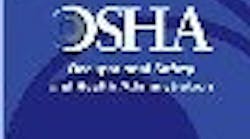Recent costly experiences of several clients indicate a need for all companies to prepare for the eventuality of an OSHA inspection.
Here we discuss federal OSHA inspections, which apply in the majority of states. But many states operate their own workplace safety and health enforcement programs, and their inspection protocols may differ slightly. You can identify the states that operate their own safety and health enforcement program at www.osha.gov/fso/osp/faq.html#oshaprogram.
|
View more safety content on PlantServices.com |
OSHA conducts inspections for a variety of reasons. The most common include a fatality, a catastrophe (hospitalization of three or more from the same accident), an employee complaint, a referral, a high-profile accident, a special-emphasis program, the site-specific targeting initiative (SST), or an observed hazard or violation.
While many employers believe an employee complaint triggers most inspections, the vast majority of complaints are settled through telephone, fax and mail correspondence with OSHA. Properly handled, most complaints are either dismissed or corrected without an inspection. However, a formal written complaint requires OSHA to respond in person to investigate as required by the Occupational Safety and Health (OSH) Act.
The most basic elements of the inspection process are:
Credentials: The compliance officer should offer identification, but if not, you should definitely ask for it. Refuse the inspection if the officer cannot produce proper identification.
Opening conference: If the compliance officer does not offer one, ask for an opening conference. The compliance officer should explain why the inspection is being conducted, what information or documentation is needed, how long it may take, etc.
In my 25 years of experience, the biggest mistake employers make is not asking OSHA why they are conducting the inspection. The answer could help either eliminate the need for the inspection or sharply narrow its focus. If the inspection is based on a complaint, the compliance officer is required to allow you to review a copy of the complaint. While the complaint will never identify the name of the employee or person who filed it, the nature of the alleged hazards and violations will be identified.
Once you have determined the reason for the inspection, you now must determine if you will allow the inspection to continue. If you refuse the inspection, OSHA will obtain a bench warrant that will require you to submit to the inspection. Some companies use this as standard operating procedure, but I advise against it. This can give an otherwise reasonable compliance officer a case of attitude upon returning with the warrant. Follow your company’s policy, but my advice in most cases is to allow the inspection to occur.
Some employers request the compliance officer to wait until a person responsible for such matters is available. OSHA will generally grant such a delay. In general, OSHA may agree to wait an hour or so for such a company official to arrive.
The inspection: Always accompany the compliance officer at all times during the inspection. Expect OSHA to take photographs and probably video. You should be prepared to do the same from both the same angle as the inspector and other angles that could support your case for compliance. Don’t be afraid to ask what or why they are looking at something. OSHA has the right to speak to employees in private, so be prepared for them to ask you to step aside while they interview your employees.
Except for hazards and violations the compliance officer observes during the inspection, the inspection should be limited to the hazards alleged in the complaint. I’ve heard stories of employers who built tunnels of plywood along the route to a machine identified in a complaint to prevent the inspector from looking at other areas of the plant.
Fix or correct whatever you can during the inspection. OSHA has a “quick fix” program that drastically reduces the amount of the penalty.
Closing conference: OSHA should offer, or you should request, a closing conference. This can sometimes occur days or weeks after the inspection, especially if OSHA is waiting for information from you or others.
OSHA should disclose the potential violations they found during the closing conference. If you have information that contradicts the violation, present it during the closing conference. Eliminating violations during this part of the process is easier than waiting until the violations are issued.
As OSHA continues to change the way it does business, it’s more likely your plant or business will be inspected. The more you know about handling an OSHA inspection, the more likely your experience will be less painful and less costly. The useful OSHA publication, “Employer rights and responsibilities following an OSHA inspection,” may be found at www.osha.gov/Publications/osha3000.pdf.
Employers do have rights during the inspection process, but you must be aware of what they are if you hope to exercise them.
Gary Glader, CSP, is president of Network Safety Consultants (www.networksafetyconsultants.com), a wholly owned subsidiary of The Horton Group. E-mail him at [email protected].
